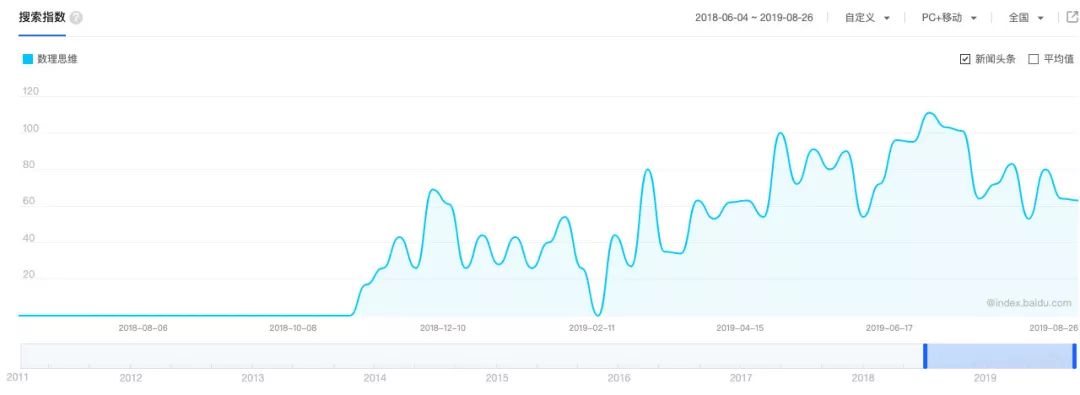The rise of mathematical thinking, who is occupying the hurdles?
Editor’s note: This article is from WeChat public account “Blackboard Insight” (ID: heibandongcha), the author unicorn.
leading
On September 4, 2019, Pea Thinking announced the completion of the New Oriental lead investment of several hundred million B round financing. In the 2019 mathematics thinking track financing process, almost every month, new players get financing. Pea thinking and spark thinking have won two rounds of financing in half a year, and the total financing amount exceeds 100 million US dollars.
Policy, capital, and players are all catalysed by the three parties. At one time, the mathematics thinking track has a chance to catch up with the children’s language training. To become the next hurdle track?
Regardless of whether the wind that wrinkles a pool of spring water rises, or goes straight into the depths of the white clouds, what is certain is that the mathematical thinking track is getting windy.
01, Battle of C-bits of mathematical thinking
The mathematical thinking is the extension of mathematics and the grafting of quality education to exam-oriented education. Compared with traditional mathematics, mathematics thinking is more extensive, integrating mathematics, children’s psychology, brain science and other subjects, focusing on the cultivation of students’ logical thinking ability and judgment ability, enhancing students’ diverse thinking and comprehensive quality. ability.
Although this concept sounds relatively frontier, it really counts, it is not a new thing in the past one or two years, but along with mathematics training. As early as 2009Jingrui Education has established “To Hui Xue Tang”, which offers a variety of thinking courses such as logical thinking and STEAM creation, focusing on cultivating children’s comprehensive learning ability. In the future, Mobie Thinking Hall will be established in 2011 to train mathematics for young children and explore the course of turning pure mathematics into mathematics thinking training.
Even if it was a big early day, it was not until 2018 that the mathematical thinking track became a real voice. According to the Baidu Index, the “mathematical thinking” entry began to have volume from around November 2018. Except for the fall during the Spring Festival, so far, the mathematical search term index has been continuously fluctuating, and the heat has only risen. What is the reason for the mathematics thinking track to be favored by capital players at this stage?

02, Mathematical thinking of three winds and fires
1, the policy corresponds to the limitations of the test education, which laid the foundation for mathematical thinking
Since February 2018, the national policy has strictly regulated the subject-based training. Super-teaching, various examinations and competitions linked to enrollment, and over-work after class have become the focus of rectification. The phenomenon of discipline-based training has been hindered, and quality education has ushered in new opportunities. In July, the Ministry of Education carried out the special management of kindergarten “primary school”. Although the Ministry of Education strictly ordered kindergartens to go to primary school, the demand for young children still existed, and the young connection training became the choice of more parents.
Under the influence of various factors such as “burden reduction” and “Olympic cups stop”, the subject products are gradually iterative to the quality category. The “mathematical thinking” continues the boundary of the mathematics discipline and becomes an important export of the quality of the subject education, which naturally becomes the new favorite of the educational institution.
2, the upgrade of consumption has driven the development of quality education
85 After the 90s, the new generation of parents gradually became the main force of children’s educational consumption. The new generation of parents are generally highly educated and willing to invest more education funds and energy for their children. The demand for nurturing children’s comprehensive literacy is also constantly escalating, from the traditional test-oriented education to the gradual transition to quality education. Economic development has also led to an increase in consumer demand, and the increase in disposable income has enabled new generation parents to afford high-priced, high-quality products. The children of 3-8 years old are at the critical stage of thinking development. Mathematics is the best carrier for cultivating children’s thinking and has been welcomed by parents.
In addition, in the past two years, Internet practitioners have borrowed the experience of online children’s English to transfer mathematics thinking training from offline to online. Advances in technology have made the mathematical thinking curriculum possible online, and onlineization has enabled players of mathematical thinking to cover a wider area.
3, the rise of children’s programming has promoted the fiery heat of the mathematical thinking track
The rise of children’s programming has also promoted the fieryness of the mathematical thinking track to a certain extent. The State Council promulgated the “New Generation Artificial Intelligence Development Plan”, pointed out the implementation of the National Intelligence Education Project, and set up artificial intelligence related courses in the primary and secondary schools to gradually promote programming education. The national policy is biased towards children’s programming, which makes children’s programming ushered in a big fever.
But in terms of implementation, programming education is more advanced, and children are not established because of their younger age, the most basic mathematical knowledge, physics knowledge, and the underlying logic of thinking. Direct contact with programming education, most of the young children can not really adapt to the course, it will be difficult to learn.
Logic is the foundation of programming. Mathematics is the foundation of logic. Agile, orderly, and precise thinking skills are the foundation of these foundations. Mathematical thinking, with its advantage of being able to achieve the guidance of thinking, is more suitable for the learning of young children, and it has become a pass for children who learn programming in the future.
At the same time, the mathematical thinking training market has a huge incremental space compared to the track for children’s language training. According to Guangzheng Hengsheng, the market size of children’s mathematical thinking is about 11 billion yuan, and even the market rules of 100 billion yuan may be formed in the future.mold. This means that the mathematical thinking track will be the next investment.
03, In the market of 10 billion, Who is occupying the pit?
In contrast to the huge market size and huge incremental space, mathematical thinking is still a fresh field compared to other tracks, and there is no real “unicorn”. As a result, educational institutions have accelerated their distribution.
Not only pea thinking, spark thinking, love thinking, you are shooting vertical field players who focus on mathematical thinking, but also Netease has a good way, VIPKID, 猿 counseling, head 1 to 1 and other giants plus code Influx, grab the pit. Even recently, VIPKID has also crossed the boundaries of mathematical thinking, launching “噜啦数学” products…..
Capital competition, each player has a layout, and the mathematical thinking track has no two.
According to the incomplete statistics of the blackboard, at least 14 companies have received financing at the Mathematical Thinking Track, and many of them have large amounts of financing.
04,How does mathematical thinking develop in the future?
Overview of the mathematical thinking track, the favorable policies and the size of the tens of billions of markets have prompted the venture capital atmosphere to increase only for a period of time; on the other hand, because of its complexityThe teaching system and the characteristics of teaching and research reconstruction have also caused the shortage of teachers and teaching content.
plus the main users of the current stage of mathematical thinking are younger students, and the difficulty of obtaining customers is relatively large. How to dig out the good content of the teacher and the extension of the student’s age extension has become the focus of the current players. Throughout the huge mathematical thinking camp, the training market models of various companies are also different. And through their model, it is not difficult to see the future direction of mathematical thinking.
1, build a quality curriculum system
The mathematical thinking track has really entered people’s field of vision since 2018, and it is still new to other disciplines. There is currently no whole set of courses available on the market for direct reproduction. Mathematical thinking itself is between subject education and quality education. It combines the characteristics of multiple disciplines and the required curriculum system is relatively complicated. Correspondingly, the quality of teachers is also higher. Therefore, cultivating high-quality teachers and building a systematic content system has become the focus of current players.
2, online small class becomes a feasible mode
The mathematics thinking course originated from the offline, and now the offline market share has a giant layout. In comparison, the online market space is broader. In addition, the online teaching time utilization rate is higher, the customer price is relatively low, and the cost performance is high. The model of future mathematical thinking is more conducive to online education.
Class type, faced with younger students, subject to the child’s self-control, large class is difficult to ensure student interaction and individual attention. At the same time, the relative cost of the 1-to-1 model is relatively high, and it is not suitable for the mathematics thinking course based on understanding. Therefore, the small class may still be a feasible mode.
But as the age of the students goes up, the class will gradually expand. For example, in the primary school class, the class size is larger than that in the kindergarten stage. In the industry, the player has already explored the class to achieve 1V10. Even 1V15. For example, the future online classroom for Mobi thinking is 1V12.
3, full-length extension of all ages
The majority of users of mathematical thinking come from users in the young connection stage, ages five or six, and the children of children programming usually start at the age of six or seven, so realize the next learning age of the students. Transfer is a problem that deserves attention.
Mathematical thinking is more scalable than mathematics. It has the ability to think and imaginationReceived on other tracks, so from the mathematical thinking expansion to children’s programming, children’s language training, big language, etc. has also become the direction of choice for many players. For example, the head of the children is also doing language and learning training, and spark thinking is also on the big language course.
Conclusion
Although the mathematical thinking track has developed rapidly in recent years, most of the project financing is still distributed in the A round and before.
But due to the clear consumer demand and favorable policies, coupled with the dual attributes of discipline and quality education, the future potential of the mathematical thinking track is endless.
Players are coming to the forefront and developing rapidly. The competition pattern of the entire track has gradually become clear, and the subdivided head enterprises have initially achieved scale expansion.
In the future, these ran out head companies will also enter a new round of resource competition, opening a new journey in the battle for brand, word of mouth, and product advantages.



